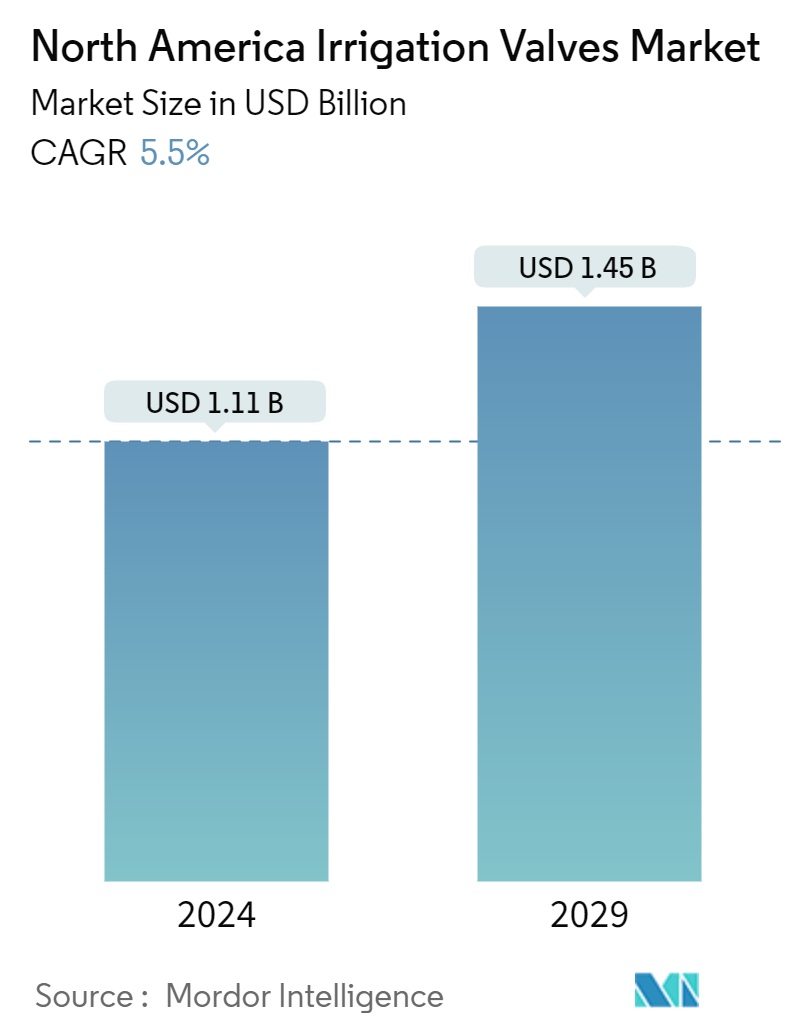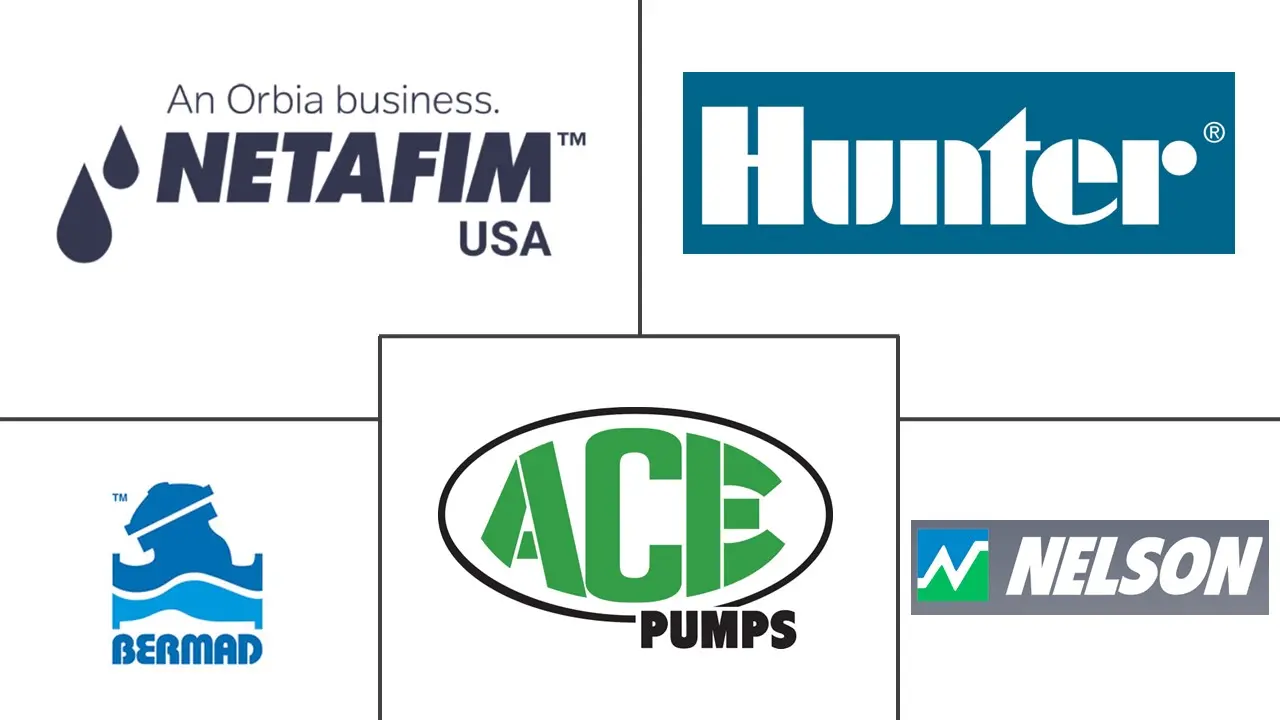Market Size of North America Irrigation Valves Industry

| Study Period | 2019 - 2029 |
| Base Year For Estimation | 2023 |
| Market Size (2024) | USD 1.11 Billion |
| Market Size (2029) | USD 1.45 Billion |
| CAGR (2024 - 2029) | 5.50 % |
| Market Concentration | Medium |
Major Players
*Disclaimer: Major Players sorted in no particular order |
North America Irrigation Valves Market Analysis
The North America Irrigation Valves Market size is estimated at USD 1.11 billion in 2024, and is expected to reach USD 1.45 billion by 2029, growing at a CAGR of 5.5% during the forecast period (2024-2029).
Several factors, like increasing population, growing adoption of advanced technologies, increasing initiatives for water conservation, raising awareness of automated irrigation, etc., are playing an essential role in the growth of the studied market.
- Smart irrigation systems are becoming rapidly popular among farmers and homeowners due to their numerous benefits. A smart irrigation system is programmed remotely to turn off or on the water flow when it detects a problem. This aids in preventing water waste, reduces water bills, and simultaneously saves the environment.
- The traditional irrigation systems have led to enormous amounts of fresh water getting wasted in the seas. Smart irrigation systems have become the answer to wastefulness and inefficient crop watering problems. An IoT-based smart irrigation technology waters plants when it is truly needed, as these smart sprinkler systems are fully automated and controlled by sophisticated sensor technology. Additionally, new advancements like low-flow rate emitters, micro-sprinklers plus variable rate irrigation, and moisture sensors enable farmers to precisely manage how much and how often they run their automatic sprinkler systems to meet their crop needs.
- Risers, timers, and valves are the parts that are commonly utilized in most irrigation systems. Valves allow a farmer to adjust the application rate between different system sections. Hence, the increasing adoption of sophisticated irrigation technology is anticipated to offer lucrative opportunities for the growth of the studied market.
- To cater to the increasing demand for irrigation valves, several market players are launching advanced products by way of extensive investments in R&D and collaborations. For instance, in June 2021, PRIER launched a new P-6IV irrigation valve, which comes with a built-in elbow that swivels to facilitate easy installation and reduced cost for extra parts. It allows servicing from the structure's exterior rather than entering the residence. The P-6IV is available in 12 lengths to suit a broad range of installation needs across the United States and Canada.
- On the flip side, raw materials account for more than half of the overall cost of the product. The quantity of R&D required to meet the advances in the valves market is significant. Such challenges limit the ability of irrigation valve manufacturers and suppliers to meet market demand. Furthermore, raw materials such as stainless steel, ductile iron, and carbon steel in the form of the forge are critical in the manufacture of valves. Prices for these products have been rising and fluctuating for a variety of reasons, including increased transportation costs. As a result, these factors are projected to impede market growth over the forecast period.
North America Irrigation Valves Industry Segmentation
An irrigation valve aids in regulating the one-directional flow of water in an irrigation system. These valves are often found in sprinkler systems. They help control water flow in above-ground systems as well as in-ground systems that have been buried well beneath the surface to present a less cluttered, more attractive landscape.
The North America irrigation valves market is segmented by material type (metal valves, plastic valves), by valve type (ball valve, butterfly valve, globe valve, automatic valves), by application (agricultural applications, non-agricultural applications), and by country (United States and Canada). The report offers market forecasts and size in value (USD) for all the above segments.
| By Material Type | |
| Metal Valves | |
| Plastic Valves |
| By Valve Type | |
| Ball Valve | |
| Butterfly Valve | |
| Globe Valve | |
| Automatic Valves | |
| Others |
| By Application | |
| Agricultural Applications | |
| Non-Agricultural Applications |
| By Country | |
| United States | |
| Canada |
North America Irrigation Valves Market Size Summary
The North America Irrigation Valves Market is poised for significant growth, driven by factors such as population increase, technological advancements, and heightened awareness of water conservation. The adoption of smart irrigation systems, which utilize IoT technology to optimize water usage, is gaining traction among both farmers and homeowners. These systems help mitigate water waste and reduce costs, aligning with environmental sustainability goals. The market is characterized by the integration of advanced components like low-flow rate emitters and moisture sensors, which enable precise water management. However, challenges such as fluctuating raw material costs and the substantial R&D investment required to keep pace with technological advancements may impede market growth.
The United States holds a dominant position in the North America Irrigation Valves Market, supported by favorable climatic conditions and a robust agricultural sector. Government initiatives and policies aimed at enhancing agricultural productivity and resource efficiency are expected to create numerous opportunities for market players. The market is moderately competitive, with key players focusing on innovation and strategic collaborations to meet evolving consumer demands. Recent product launches and expansions by companies like Belimo and Flowserve Corporation highlight the ongoing efforts to optimize irrigation and control systems. These developments, coupled with supportive government policies and sustainability initiatives, are likely to drive the market's expansion over the forecast period.
North America Irrigation Valves Market Market Size - Table of Contents
-
1. MARKET INSIGHTS
-
1.1 Market Overview
-
1.2 Impact of COVID-19 on the Market
-
1.3 Industry Value Chain Analysis
-
1.4 Industry Attractiveness - Porter's Five Forces Analysis
-
1.4.1 Threat of New Entrants
-
1.4.2 Bargaining Power of Buyers
-
1.4.3 Bargaining Power of Suppliers
-
1.4.4 Threat of Substitute Products
-
1.4.5 Intensity of Competitive Rivalry
-
-
-
2. MARKET SEGMENTATION
-
2.1 By Material Type
-
2.1.1 Metal Valves
-
2.1.2 Plastic Valves
-
-
2.2 By Valve Type
-
2.2.1 Ball Valve
-
2.2.2 Butterfly Valve
-
2.2.3 Globe Valve
-
2.2.4 Automatic Valves
-
2.2.5 Others
-
-
2.3 By Application
-
2.3.1 Agricultural Applications
-
2.3.2 Non-Agricultural Applications
-
-
2.4 By Country
-
2.4.1 United States
-
2.4.2 Canada
-
-
North America Irrigation Valves Market Market Size FAQs
How big is the North America Irrigation Valves Market?
The North America Irrigation Valves Market size is expected to reach USD 1.11 billion in 2024 and grow at a CAGR of 5.5% to reach USD 1.45 billion by 2029.
What is the current North America Irrigation Valves Market size?
In 2024, the North America Irrigation Valves Market size is expected to reach USD 1.11 billion.

